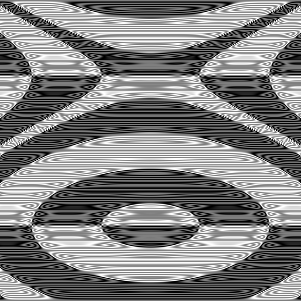Seed: 297599502514876210
Create art using Python's random module and math functions.
After completing this assignment, you should understand:
- Randomness
- The Python
randommodule - The sublime beauty of generated art
After completing this assignment, you should be able to:
- Generate images with Python
- Use randomness to construct new functions
- A Git repo called random-art containing at least:
README.mdfile explaining how to run your project- a
requirements.txtfile - a
random_artmodule - Your favorite piece of art you made, plus instructions on how to replicate it.
- No PEP8 or Pyflakes warnings or errors
You are going to make random art, inspired by
random-art.org. This project comes
with a file create_art.py. This file expects a module called
random_art with two functions:
-
create_expression(): this function takes no arguments and returns an expression that will generate a number between -1.0 and 1.0, givenxandycoordinates. -
run_expression(expression, x, y): this function takes an expression created bycreate_expressionand anxandyvalue. It runs the expression, passing thexandyvalues to it and returns a value between -1.0 and 1.0.
I'm super-glad you asked! It is a way for you to create a formula for your
random art. You can define it however you like. Perhaps it's just a function
and run_expression just runs it. Maybe it's an abstract syntax tree and
run_expression walks the tree and evaluates it. Maybe it's Python code in
a string that you call eval on. You have to figure this part out, and it's
one of the harder parts of this exercise.
The concrete thing it has to do is take an x and y value and return a new
value between -1.0 and 1.0. That doesn't tell you why or how, though.
You should randomly construct an expression that uses sin, cos, and any
other functions you want. sin and cos will definitely help you create
patterns, but you should be creative. Look at other functions available to you
and create your own functions for use.
How you randomly construct the expression is up to you. random.random() and
random.choice() are both obvious ways to construct it, but you should look
at all the different functions for random distributions and consider them.
This image was created with the following expression:
sin(pi * sin(pi * sin(pi * (sin(pi * sin(pi * sin(pi * sin(pi *
cos(pi * y))))) * cos(pi * sin(pi * cos(pi *
avg(sin(pi * y), (x * x)))))))))create_art.py takes several command-line parameters you may want to use.
-
--seed SEEDsets the random seed to a particular number. This is great for being able to generate the same image more than once. -
-n NUMor--number NUMsets how many images to create.NUMis 1 by default. -
--grayor--colorsets whether the image is in grayscale or color. Color is default.
Modified from a "nifty assignment" from the annual SIGCSE meeting.
